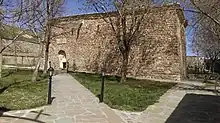Sargis
Sargis or Sarkis (Armenian: Սարգիս, Armenian pronunciation: [sɑɾˈkʰis]; Syriac: ܣܪܓܝܣ, Syriac pronunciation: [sargis]) is a male given name in both Armenian[1] and Assyrian[2] communities. The Armenian surname Sargsyan/Sarkisian is derived from this name.
| Gender | Male |
|---|---|
| Origin | |
| Word/name | Armenian, Syriac |
| Meaning | Protector |
| Region of origin | West Asia |
| Other names | |
| Alternative spelling | Sarkis, Sarkees, Serkis |
| Nickname(s) | Seggy, Sagi, Sago, Sako, Seggo |
| Related names | Sergius, Sargent |
Assyrian Tradition

Saints Sergius and Bacchus with their names written in Syriac. Sargis is seen on the right in this iconography with the caption ܡܪܝ ܣܪܓܝܣ (Mar Sargis) above him.
In the Assyrian community, the name Sargis is a common veneration to Saint Sergius who was martyred in the Syriac speaking city of Resafa,[3][4] popularizing the name in the language amongst liturgically Syriac speaking communities since at least the 4th century. The name Assyrian Neo-Aramaic: ܡܪܝ ܣܪܓܝܣ, Syriac pronunciation: [mar sargis], meaning Saint Sargis, is also used for Assyrian churches in both the Assyrian homeland[5] and diaspora.[6]
List of notable people or places with the name Sargis
Saints

The Armenian Saint, Sargis the General
- Sargis the General, 4th century Armenian saint, not to be confused with Saint Sergius
- Sergius of Samarkand, Church of the East saint (fl. at least prior to the conversion of Keraites around 1007)
Places
- Mar Sargis Village, an Assyrian settlement located near Seiri, Urmia, Iran
Churches
- Mar Sargis Assyrian Church of the East (3rd Century AD)
- Saint Sargis Church of Ashtarak
- Saint Sargis Monastery of Ushi
- Saint Sargis Church of Tabriz
- Mar Sargis Assyrian Church of the East in Skokie, Illinois
Mononym
- Sargis of Aïbeg and Serkis
- Sargis (Nestorian Patriarch), Patriarch of the Church of the East (860-872)
First name
- Sargis I Jaqeli (died 1285), Georgian nobleman of the House of Jaqeli and sovereign Prince
- Sargis Barkhudaryan (1887–1973), Armenian composer, pianist and educator
- Sargis Hovhannisyan (born 1968), Armenian football player
- Sargis Hovsepyan, (born 1972), Armenian football player
- Sargis Kakabadze (1886-1967), Georgian historian and philologist
- Sargis Karapetyan (born 1990), Armenian football player
- Sargis Mehrabyan (died 1943), Armenian military figure
- Sargis Pitsak, early 14th century Armenian artist
- Sargis Sargsian, (born 1973), former professional tennis player from Armenia
- Sargis Tmogveli, late 12th and early 13th century Georgian statesman and writer.
- Sargis Yosip, Assyrian bishop from Iraq
- Sargis Reshaina, 6th century physician and priest who translated Greek medical works into Syriac
- Sargis Bkhira
Last name
- Ashur Bet Sargis (born 1949), Assyrian composer and singer
- Hayden Sargis, Assyrian soccer player
References
- Hanks, Patrick (2003). Dictionary of American Family Names. Oxford University Press. p. 271. ISBN 9780199771691.
Sargis (177) Reduced form of Armenian Sargisian, western Armenian form of SARKISIAN
- Hanks, Patrick (2022). "Names from Africa, the Middle East, and the Indian Subcontinent". Dictionary of American Family Names, 2nd Edition. Oxford University Press. ISBN 9780190245115.
Assyrian/Chaldean: from a Syriac equivalent of the Latin personal name Sergius (see Sergio) a Christian saint's name. Compare Sarkis American shortened form of Armenian Sargsyan or its rare variant Sargisyan. (Compare Sarkis)
- Aboud, Ibrahim George. "Religion in language policy, and the survival of Syriac". CSUSB ScholarWorks. California State University, San Bernardino. p. 30. Retrieved 8 December 2022.
Despite all these developments, Syriac continued to be used by Chalcedonian rural communities in Syria until the end of the Middle Ages...To the East, in the city of Sergiopolis in the Syrian Desert, the columns' inscriptions found in the sixth century main cathedral used reversed Greek, written from right to left like Syriac
- "Greek and Syriac inscriptions on the chancel screen of the church of *Sergios (soldier and martyr of Rusafa, S00023) in Zabad (near Anasartha, to the southeast of Chalkis and Beroia/Aleppo, north Syria), listing donors involved in the construction of this sanctuary, and possibly invoking Sergios. 6th c. (after 511)". figshare. pnowakowski. Retrieved 8 December 2022.
- "MAAR-SARGIZ HISTORICAL CHURCH". Iran Touring and Tourist Organization. Retrieved 8 December 2022.
- "Assyrian Church of the East - Mar Sargis IL". assyrianchurch.net.
This article is issued from Wikipedia. The text is licensed under Creative Commons - Attribution - Sharealike. Additional terms may apply for the media files.
